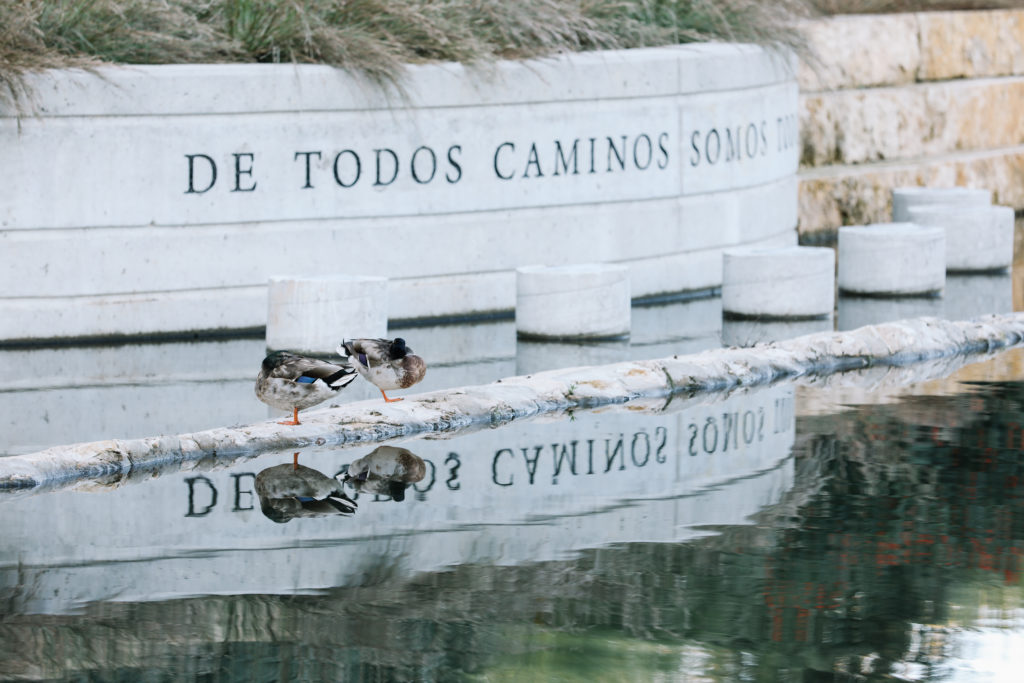From the striking murals located throughout the trail to the flood bypass tunnel that depicts the night sky from 1718, San Antonio’s culture and history are central in every public art piece along the San Pedro Creek Culture Project. Perhaps no piece of artwork is as initially stunning or unifying as the 120-foot long mural, created by local artist and west side native Adriana Garcia. It depicts the confluence of cultures that have made their home along the banks of the creek over the last several hundred years. The theme of the piece is “from all roads, we are one.”
All four city blocks of the San Pedro Creek Culture Project were built with the environment in mind: bioswales slow and clean stormwater through natural landscape features; interceptors collect larger debris and trash before it gets to the mouth of the creek; and aquatic and native plants attract herons, ducks, and other bird species. Rotating workshops offer opportunities for the community to learn more about the ecology of the project.
“We really wanted this park to be a place that you would want to visit over and over again—a place where there was room for multiple voices and multiple points of view to kind of interpret not only what they see there physically, but also interpret what they may have experienced as a child,” said Carrie Brown, the public arts director for the project. Carrie imagined grandparents strolling with their grandkids, explaining how the creek and the surrounding neighborhood had changed over time, pointing out what was there before and envisioning the future.

Photo by Vanessa Velazquez
In 2010, the community envisioned San Antonio as a respectful steward of its natural resources and a model for responsible resource management. The community envisioned parks and open spaces complementing smart growth patterns, resulting in a livable and vibrant community that is strongly connected to its past and maintains its small-town feel. As a result of the park, many San Antonians now enjoy what was once a drainage ditch as a place to walk, bike, spend time with their families, and learn about history, art, and ecology.
The San Pedro Creek Culture Project is a beautiful testament to our Community Vision, as well as the understanding that there is still more work to be done. While continued expansion plans for the project will help better connect our city’s west side to the center city, the project unintentionally displaced San Antonians living closest to the park. Suzanne Scott, general manager of San Antonio River Authority (SARA), recognizes the importance of having conversations early on about the impact of each project, to analyze potential unintended consequences and create strategies to prevent or mitigate displacement. “We wanted those residents that were living there at the time … to be the ones that were going to be able to enjoy” the project, she said. “So, we just need to be a lot more thoughtful.”
Protecting and promoting neighborhoods is one of five action items that emerged from the collaborative work of the Mayor’s Housing Policy Task Force. (Read more about this in Neighborhoods.) More specifically, to prevent and mitigate displacement, the Task Force recommended that the City of San Antonio require public agencies to conduct a displacement impact assessment for any public project that received $15 million or more in public investment. Additionally, it was recommended that the City create a fund to mitigate the impact of displacement, while also funding proactive outreach and counseling to households experiencing housing vulnerability.

Photo by Vanessa Velazquez
The San Pedro Creek Culture Project, with one of four phases now complete, represents a current $178 million local investment. “For San Antonio to really move forward in sustainable development practices, we have to show that these practices work on public projects first,” explained Suzanne. “It’s very challenging to tell a private developer you should be putting in low impact development, if you’re not doing it yourself.” More than a testament to our shared goals, the world-class linear park represents the potential for us to model what we want for our community—in Environmental Sustainability and beyond.

